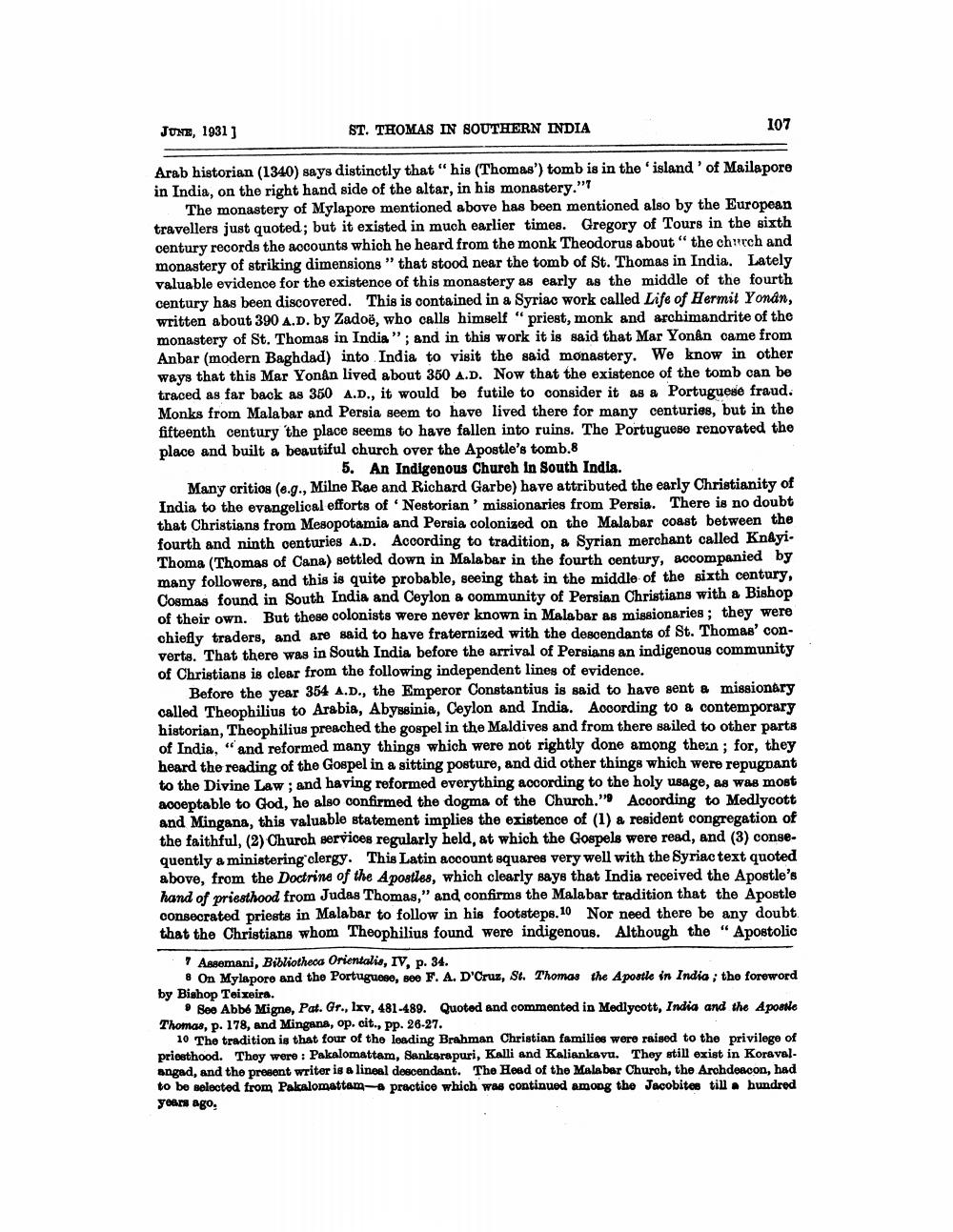________________
JUNE, 1931)
ST. THOMAS IN SOUTHERN INDIA
107
Arab historian (1340) says distinctly that "his (Thomas') tomb is in the island of Mailapore in India, on the right hand side of the altar, in his monastery."
The monastery of Mylapore mentioned above has been mentioned also by the European travellers just quoted; but it existed in much earlier times. Gregory of Tours in the sixth century records the accounts which he heard from the monk Theodorus about "the church and monastery of striking dimensions” that stood near the tomb of St. Thomas in India. Lately valuable evidence for the existence of this monastery as early as the middle of the fourth century has been discovered. This is oontained in a Syriao work called Life of Hermit Yonan, written about 390 A.D. by Zadoë, who calls himself "priest, monk and archimandrite of the monastery of St. Thomas in India"; and in this work it is said that Mar Yonan came from Anbar (modern Baghdad) into India to visit the said monastery. We know in other ways that this Mar Yonan lived about 350 A.D. Now that the existence of the tomb can be traced as far back as 350 A.D., it would be futile to consider it as a Portuguese fraud. Monks from Malabar and Persia seem to have lived there for many centuries, but in the fifteenth century the place seems to have fallen into ruins. The Portuguese renovated the place and built a beautiful church over the Apostle's tomb.8
5. An Indigenous Church in South India. Many critios (6.g., Milne Rae and Richard Garbe) have attributed the early Christianity of India to the evangelical efforts of Nestorian 'missionaries from Persia. There is no doubt that Christians from Mesopotamia and Persia colonized on the Malabar coast between the fourth and ninth centuries A.D. According to tradition, a Syrian merchant called Knayi. Thoma (Thomas of Cana) settled down in Malabar in the fourth century, accompanied by many followers, and this is quite probable, seeing that in the middle of the sixth century, Cosmas found in South India and Ceylon a community of Persian Christians with a Bishop of their own. But these colonists were never known in Malabar as missionaries; they were chiefly traders, and are said to have fraternized with the descendants of St. Thomas' converts. That there was in South India before the arrival of Persians an indigenous community of Christians is clear from the following independent lines of evidence.
Before the year 354 A.D., the Emperor Constantius is said to have sent & missionary called Theophilius to Arabia, Abyssinia, Ceylon and India. According to a contemporary historian, Theophilius preached the gospel in the Maldives and from there sailed to other parts of India, "and reformed many things which were not rightly done among then; for, they heard the reading of the Gospel in a sitting posture, and did other things which were repugnant to the Divine Law; and having reformed everything according to the holy usage, as was most acceptable to God, he also confirmed the dogma of the Church." Acoording to Medlycott and Mingana, this valuable statement implies the existence of (1) a resident congregation of the faithful, (2) Church services regularly held, at which the Gospels were read, and (3) consequently a ministering clergy. This Latin account squares very well with the Syriac text quoted above, from the Doctrine of the Apostles, which clearly says that India received the Apostle's hand of priesthood from Judas Thomas," and confirms the Malabar tradition that the Apostle consecrated priests in Malabar to follow in his footsteps.10 Nor need there be any doubt. that the Christians whom Theophilius found were indigenous. Although the "Apostolic
Assemani, Bibliotheca Orientalis, IV, p. 34.
& On Mylapore and the Portugues0, 10 F. A. D'Cruz, St. Thomas the Apostle in India, the foreword by Bishop Teixeira.
See Abbé Migne, Pat. Gr., lxv, 481-489. Quoted and commented in Medlycott, India and the Apostie Thomas, p. 178, and Mingana, op. cit., pp. 26-27.
10 The tradition is that four of the leading Brahman Christian families were raised to the privilege of priesthood. They were : Pakalomattam, Sankarapuri, Kalli and Kaliankavu. They still exist in Koravalangad, and the present writer is a lineal descendant. The Head of the Malabar Church, the Archdeacon, had to be selected from Pakalomattam practice which was continued among the Jacobite till. hundred you ago.




